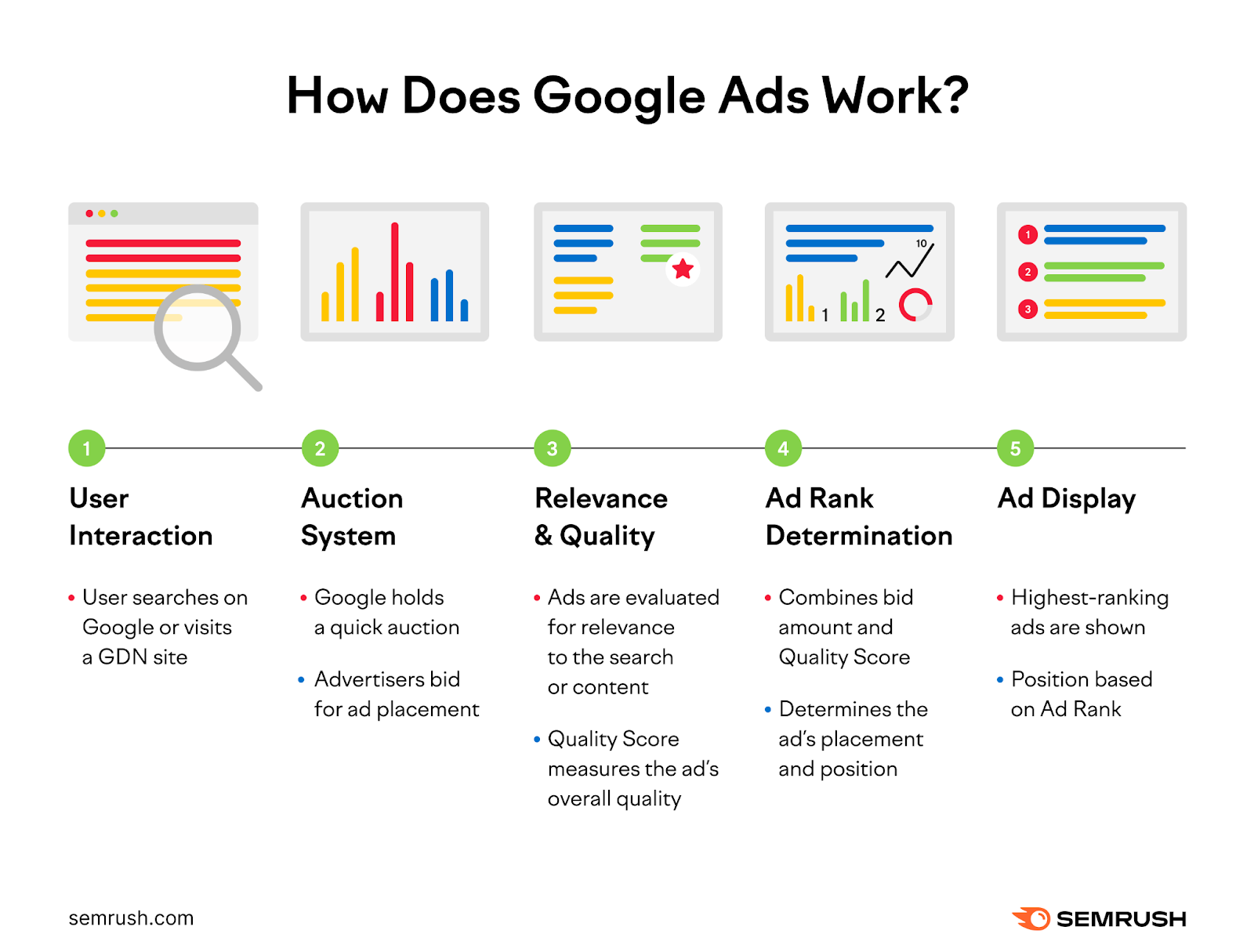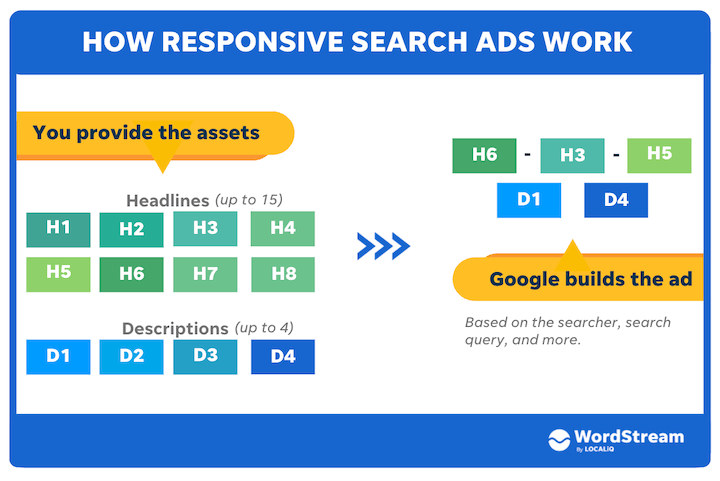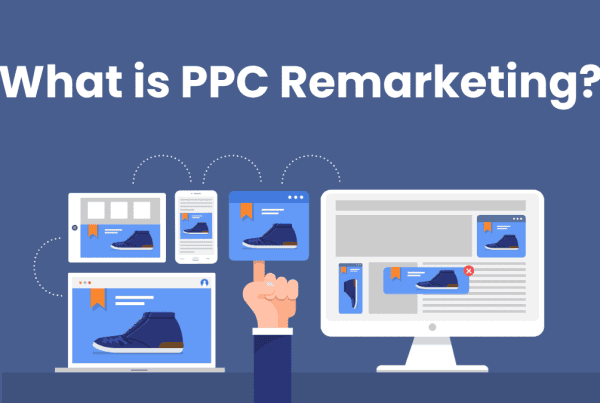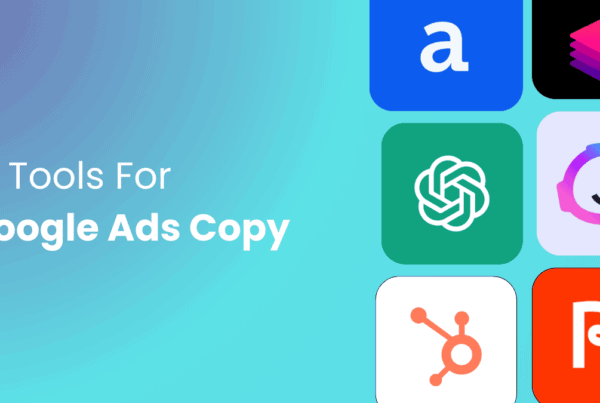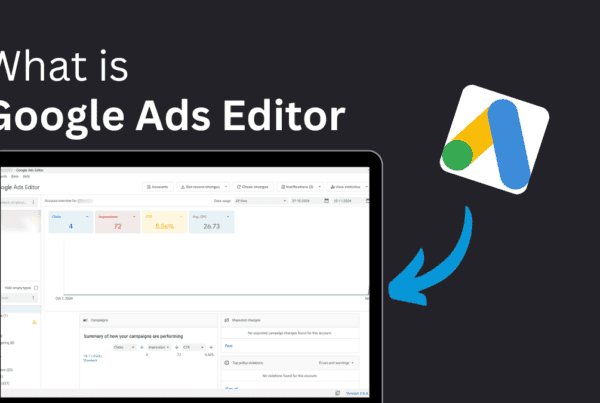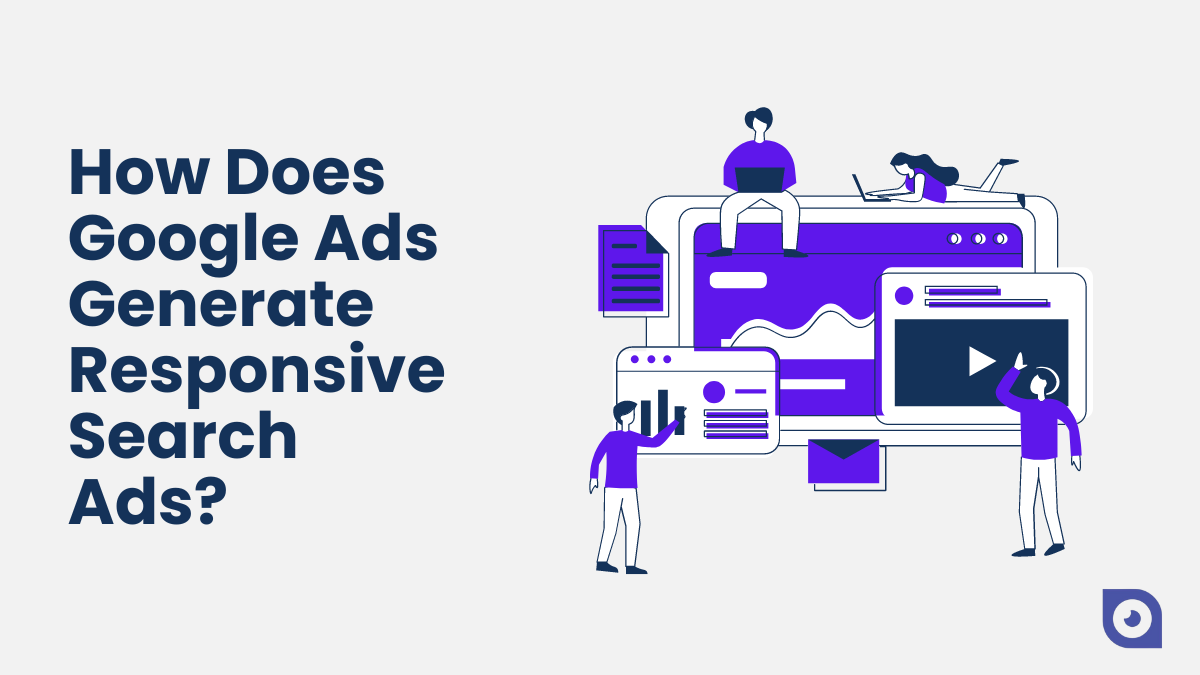
Nowadays, marketing is very important for businesses to find and grow their customers. One way of marketing is advertising, which helps businesses get people’s attention and tell them what they offer.
Advertising has changed a lot because of technological advancements. Businesses now use online ads more than old-fashioned ads like newspapers and TV, because online ads can reach more people and cost less money.
Online ads have many types, such as ads that show up when you search for something, ads that appear on websites, ads that you see on social media, ads that play before videos, and so on.
Each type of ad has its own advantages and rules. One new and effective type of ad format is called Responsive Search Ads (RSAs). It helps businesses make and improve their search ads.
In this article, we will learn more about Responsive Search Ads (RSAs), how they are made, and how they can help businesses get better results. Keep reading as we explain how Google Ads and Responsive Search Ads work!
Understanding Google Ads
Google Ads is a strong online advertising platform made by Google. It lets businesses show their ads on Google’s search pages and other websites that work with Google. Google Ads works on a pay-per-click (PPC) model, where advertisers choose words that are related to their business.
When users search for these words, Google shows the advertiser’s ads in the search page. The place of these ads is decided by the Ad Rank, a number based on how much the advertiser pays and how good the ad and the website are.
When a user clicks on the ad, they go to the advertiser’s website, and the advertiser pays some money. This model makes sure that advertisers only pay when people who might buy their products or services by clicking on their ads, making Google Ads a cheap advertising solution.
Google Ads is very important for digital marketing. Since most people start their online activities with a search engine, Google Ads gives businesses a special chance to reach people who are looking for the products or services the business has, as its intent based advertising.
Also, with its smart targeting options, progress tracking, and ability to grow, Google Ads has become a very useful tool for businesses that want to grow a lot in the digital world.
What are Responsive Search Ads?
Responsive Search Ads (RSAs) is a new kind of ad that Google Ads lets you use. You can give many titles and details for your ads. Google’s smart systems then try different ways to show your ads and learn which ones work best for any search. This means your ads can change and give the right message to the right person at the right time. Advertisers who switch from expanded text ads to RSA using the same assets get an average of 7% more conversions at the same cost per conversion.
Furthermore, by Google experimenting with the different permutations and combinations of what works best, the hypothesis is that conversion rates should go higher once the algorithm figures out what’s performing based on all the combinations it has tried.
Also, responsive search ads can show up to three titles and two long details, while normal search ads can only show up to two titles and one short detail. Responsive search ads are a big improvement in search engine advertising, giving a more flexible and powerful way to reach people who might buy your products or services.
Benefits of using Responsive Search Ads
Responsive search ads are good for advertisers in many ways:
- Easy and Fast: RSAs make the ad testing process easier by using different titles and details. This saves advertisers the time and work of trying different ad combinations by themselves.
- Better Ad Performance: By trying different combinations, RSAs can show ads that are more related to what people search for. This can make more people click on the ads and maybe buy more products or services.
- More Personalized Ads: With many titles and details, RSAs can give a more personal ad that matches what a user wants more closely.
- More Visibility: RSAs can show up in more places and for more searches, making your ad more seen and reached.
- More Flexible: RSAs change the ad based on what the smart systems learn about how users act, making sure the right message is given to the right user at the right time.
By using these benefits, advertisers can make their digital marketing better and get better results.
How to Create Responsive Search Ads?
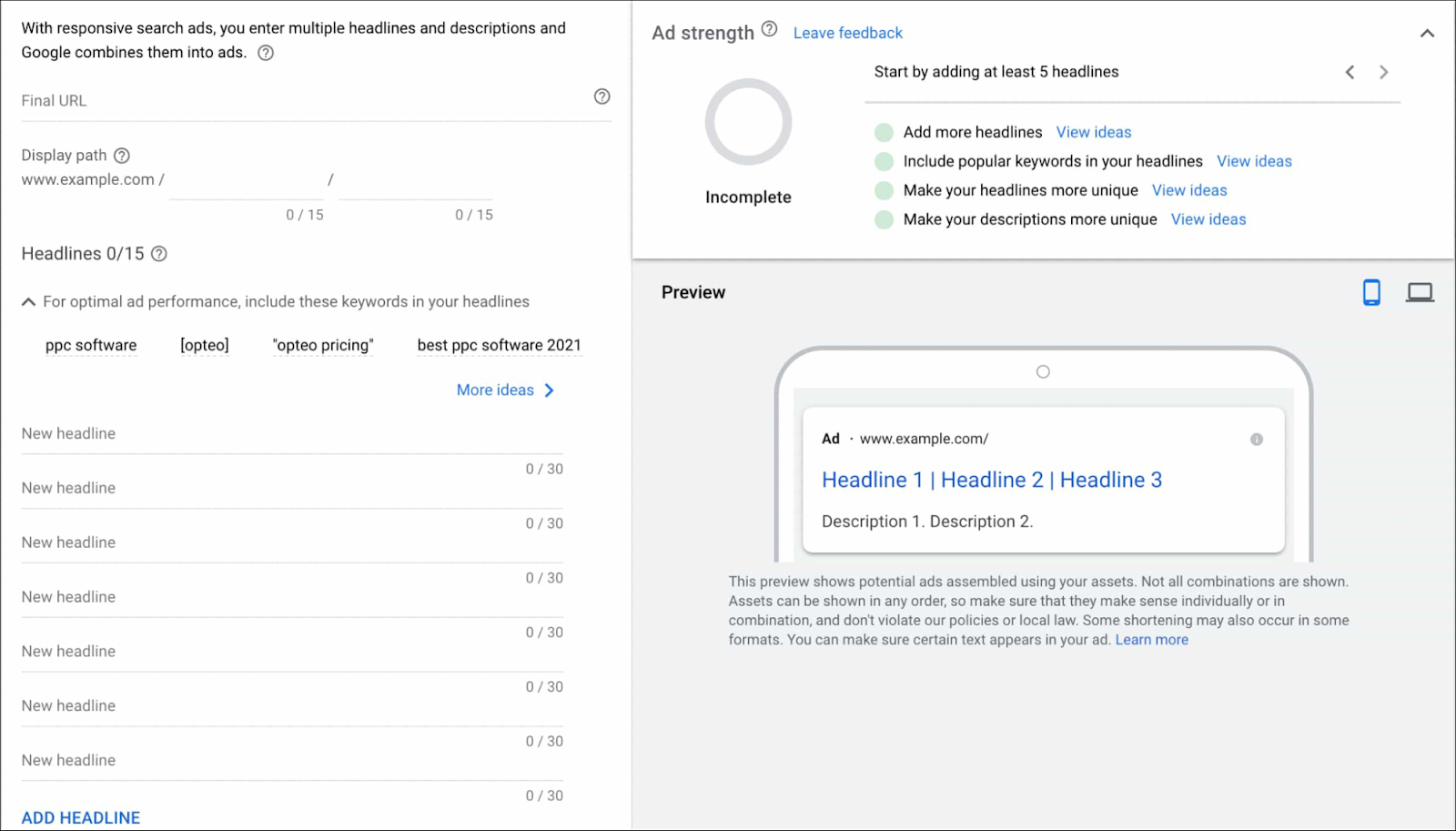
Responsive Search Ads (RSAs) are a powerful tool in Google Ads that allow advertisers to create flexible and optimized ads. Here’s a step-by-step guide on how to create RSAs in Google Ads, followed by some valuable tips for creating the best and most optimized RSAs.
Step-by-step Guide to Create Responsive Search Ads in Google Ads
- Navigate to the Google Ads homepage and sign in with your account credentials.
- From your Google Ads dashboard, select the campaign where you want to add the RSA.
- You can either create a new ad group for your RSA or select an existing one.
- Once you’re in the ad group, click on ‘+ New Ad’ and then select ‘Responsive Search Ad’.
- You can enter up to 15 headlines and 4 descriptions. Google Ads will automatically test different combinations of your headlines and descriptions and learn which combinations perform best.
- You can preview how your ad might appear in different combinations before you save it.
- Once you’re satisfied with your headlines and descriptions, click ‘Save’.
Valuable Tips for Optimized Responsive Search Ads
- Utilize all available space: Make sure to use as many headlines and descriptions as possible. This gives Google more options to test and optimize your ad.
- Include keywords: Include at least one of your keywords in your headlines. This can make your ad more relevant to what people are searching for.
- Create unique headlines: Ensure each headline is distinct. This provides a wider variety of ad combinations.
- Use popular search terms: Incorporate popular search terms related to your product or service in your headlines and descriptions.
- Test and refine: Monitor your RSA’s performance and make necessary adjustments. Remember, the key to a successful RSA is continuous testing and refinement.
How Does Google Ads Generate Responsive Search Ads
Responsive Search Ads (RSAs) are a dynamic ad format in Google Ads that leverage Google’s machine learning algorithms to optimize ad performance. Here’s an explanation of how Google Ads generate RSAs.
Google’s Machine Learning Algorithms
Google’s machine-learning algorithms are at the heart of RSAs. These algorithms analyze historical data and user behavior to predict which ad combinations are most likely to lead to user engagement. They consider various factors such as the user’s search query, device, browsing history, and time of day, among others.
Testing Different Combinations
When you make a responsive search ad, you give many titles and details for your ads. Google’s algorithm then makes different ways to show your ads by using these titles and details, and each way is a different ad.
These ads are tried in real-time auctions. Over time, Google’s algorithm learns which ways work best based on how users click or buy.
Optimizing Responsive Search Ads for Individual Searchers
Google’s machine learning algorithms do more by making RSAs better for each user. They do this by thinking about what the user wants, where they are, and how they acted before.
For example, if a user has clicked on similar ads before or has visited websites related to the ad’s words, the algorithm might choose to show a certain way of the ad that matches the user’s interests and behavior.
So in short, Google Ads makes RSAs by using machine learning algorithms to try different ways of showing ads and making them better for each user. This makes sure that the right message reaches the right user at the right time, making ads better.
Best Practices for Responsive Search Ads
Responsive Search Ads (RSAs) can be very effective in your Google Ads arsenal when used correctly. Here are some strategies for maximizing the performance of RSAs and common mistakes to avoid.
Strategies for Maximizing Responsive Search Ads Performance
“Responsive search ads helped us improve our search campaign ad quality and performance, and more importantly, saved our time in optimizing and monitoring campaigns,” says Azila Prabaningtyas Utami, media performance manager at Starcom.
To make good RSAs, give good input. Here are 14 tips.
- Write short and different titles: The system makes the best title-detail pairs. Give key parts like brand, product, words, benefits, and call-to-action. For example: “BrandXYZ Model1: The best 5G smartphone.”
- Use popular words in the title Use: Use Google’s tools to find popular words. Titles with popular words get more attention. For example, KFC Brickell used words like “food near me,” “KFC delivery,” and “KFC promotion” in its ads.
- Use words that make people act: Use action words or call-to-action words like “contact us today” or “book now.” The call-to-action should match the user journey and take people to the product or service.
- Show what makes your product special: Show hooks like “50% off” and “free installments” and product features and benefits. For example, Mitsubishi showed the car’s low price and big space in its ads.
- Pin important parts to make them more seen: Pin titles and details to certain places in Search ads. This keeps important parts more seen. For example, Samsung pinned the product details and special features to the detail.
- Use all available space: Google allows up to 15 headlines and 4 descriptions in RSAs. Utilize all these options to give Google’s algorithms more material to work with.
- Include keywords: Incorporate your target keywords in your headlines and descriptions. This can increase the relevance of your ads to user searches.
- Diversify your content: Make sure each headline and description is unique. This allows for a wider variety of ad combinations.
- Leverage ad strength: Google provides an “ad strength” indicator for RSAs. Aim for ‘Good’ or ‘Excellent’ ad strength by following Google’s recommendations.
- Leverage Dynamic Keyword Insertion (DKI): DKI allows you to automatically insert the user’s search query into your ad. This can increase the relevance of your ad and improve click-through rates.
- Use Ad Customizers: Ad customizers allow you to dynamically insert specific information into your ad, such as a countdown to a sale or the number of items left in stock.
- Experiment with Punctuation and Capitalization: Different punctuation and capitalization can impact how your ad is perceived. Experiment with these elements to see what works best for your audience.
- Leverage IF Functions: IF functions allow you to customize your ad based on the user’s device or audience list. This can help you tailor your message to specific user segments.
- Test and refine: Monitor your RSA performance and make adjustments as needed. Continuous testing and refinement are key to RSA’s success.
Common Mistakes to Avoid
- Repetitive content: Avoid using the same or similar phrases in your headlines and descriptions. This limits the variety of ad combinations.
- Ignoring ad strength: Not paying attention to the ‘ad strength’ indicator can lead to suboptimal ad performance.
- Not using keywords: Failing to include keywords in your headlines and descriptions can reduce the relevance of your ads to user searches.
- Not utilizing all available space: If you don’t use all the headlines and descriptions available, you’re limiting the material Google’s algorithms have to work with.
- Not monitoring performance: RSAs require ongoing monitoring and adjustment. Ignoring RSA’s performance can lead to missed opportunities for improvement.
By following these best practices and avoiding common mistakes, you can maximize the performance of your RSAs and drive better results with your Google Ads campaigns.
Analyze Performance and Future Trends
In this section, we delve into advanced strategies for Responsive Search Ads (RSAs), how to analyze RSA performance in Google Ads, and future trends in RSAs.
Analyzing Responsive Search Ads Performance in Google Ads
Google Ads provides several metrics to help you analyze RSA performance:
- Click-Through Rate (CTR): This measures the percentage of users who clicked on your ad after seeing it. A higher CTR indicates a more effective ad.
- Conversion Rate: This measures the percentage of users who completed a desired action (like making a purchase) after clicking on your ad.
- Impressions: This measures the number of times your ad was shown. More impressions mean your ad is reaching a larger audience.
- Ad Strength: This is a measure of the quality of your ad. It takes into account factors like relevance, diversity, and quantity of your headlines and descriptions.
Future Trends in Responsive Search Ads
As machine learning algorithms evolve, we can expect RSAs to become even more effective and sophisticated. Here are a few trends to watch:
- Improved Personalization: As Google’s algorithms better understand user intent and context, we can expect RSAs to become more personalized and relevant.
- Integration with Other Google Products: We might see more integration between RSAs and other Google products, like Google Analytics and Google Business Profile.
- More Automation: As machine learning algorithms improve, we can expect more aspects of RSAs to become automated, reducing the manual work required from advertisers.
By staying up-to-date with these advanced strategies, analysis techniques, and future trends, you can ensure that your RSAs remain effective and competitive in the ever-evolving digital advertising landscape.
Conclusion
To end this article, we can say that Responsive Search Ads (RSAs) are a new and smart kind of ad in Google Ads that uses Google’s smart systems to make and improve ads for each user. By giving multiple relevant titles and details, advertisers can get many benefits from RSAs, such as saving time, getting better results, showing more personal ads, reaching more people, and changing the ads as needed.
But, to use RSAs well, advertisers need to do things, such as using good and different words, writing clear and interesting titles and details, trying different ways of showing ads, and not making common mistakes.
Also, advertisers need to check how their RSAs are doing in Google Ads and follow the new changes in RSAs, such as using words that change with the search, adding more information, and using smart ways to pay for the ads. This allows advertisers to use RSAs to reach their digital marketing goals and grow their business.
References:
- https://support.google.com/google-ads/answer/7684791?hl=en
- https://www.wordstream.com/blog/responsive-search-ads
- https://developers.google.com/google-ads/api/docs/responsive-search-ads/overview
- https://www.thinkwithgoogle.com/intl/en-apac/marketing-strategies/search/responsive-search-ads-tips/
- https://surfsideppc.com/responsive-search-ads/
- https://support.google.com/google-ads/answer/11031467

